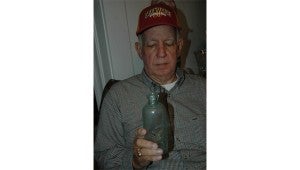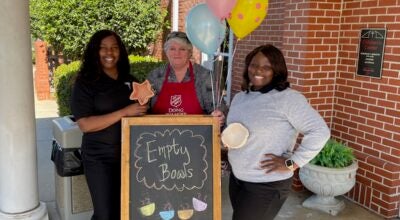Discovery leads to history lesson on Brundidge Bottleworks
Published 3:00 am Saturday, January 3, 2015

When Ty Tyson unearthed this bottle from the historic Brundidge Bottleworks, he prompted an unofficial history lesson from John Phillip Johnston (inset) who owns an extensive collection of bottles from the Brundidge plant.
Ty Tyson is not a bottle collector, but he quickly realized the bottle he just happened to dig up was one of interest.
“I got to looking at it and saw Brundidge Bottling Works on it and I got real interested,” said Tyson who lives on River Road but calls Brundidge home. “I’m interested in anything about Brundidge. So, I was curious about the bottle.”
Anyone who is curious about anything related to Brundidge goes to the Brundidge historian, John Phillip Johnston. And, if Johnston doesn’t know anything about it, then just forget it.
Johnston is admittedly a pack rat and his collection of “junk” includes bottles of different kinds, especially bottles from the Brundidge Bottling Works.
His collection of bottles from the Brundidge Bottling Works includes several bottles from a Brundidge garbage dump that were in use around 1916.
“Back years ago, Johnnie Pearl Myhand called and asked if I was still the pack rat of Brundidge,” Johnston said, laughing. “I said I was and she said she had a bottle for me that she dug up when she was digging for fish bait. It was from the old bottling works in Brundidge.”
At the time Myhand was 86 years old. She told Johnston about a dumpsite that she remembered that dated back to around 1916.
“She remembered that Lon Robinson collected garbage on a horse and wagon,” Johnston said. “One side of the wagon let down so he could dump the garbage. I knew I could probably find bottles from the bottling company at that site.”
When Johnston asked the landowner for permission to dig the dump the owner agreed but said that digging around in a dump was the stupidest thing he’d ever heard of.
But not for a bottle collector.
“I probably found 50 bottles or more before I found one that was not broken,” Johnston said. “But, in time, I found about a case of Chero Cola bottles that were bottled in Brundidge, Troy and Clio.”
The county’s history in the bottling works business dated to the early days of Coca-Cola.
The Youngbloods of Troy had the first bottling company in the county.
“Coca-Cola was founded in 1886 and the Youngbloods’ bottling works opened in 1892,” Johnston said. “What was told was that Mr. Youngblood was given the opportunity to purchase a franchise but declined, thinking Coca-Cola would never amount to anything.”
In 1907, Jones Bottling Works was founded in Troy by W.W.D. Jones. In 1910, the Jones’ brothers, Dean, Walter and Frank, opened a bottling company in Brundidge and bottled flavors including chocolate, strawberry and lime and later Chero Cola, which became the biggest competitor of Coca-Cola.
His collection includes a large number of Chero-Cola bottles, the earliest of which were clear glass. Later an aquatinted glass was used.
Back in those days, when the glass bottles were molded there was a seam on both sides that went from the bottom to the crown and the process was not perfected, Johnson said.
If the bottom of the glass bottle was uneven or if there were air bubbles in the glass, the bottle was molded before 1908 before ABM automatic bottle makers.
Johnson said Chero-Cola was short lived.
“Coca-Cola was always suing Chero-Cola maintaining they were the only company that had the rights to use cola for their products,” Johnston said “The two cola companies were in and out of court for years. I guess Coca-Cola finally wore Chero-Cola out. They changed their name to Royal Crown Cola so they went back to court. Then, they changed the name to Royal Crown and Nehi.”
Johnston’s collection includes several of those brands bottled in Brundidge, Troy and Clio.
His Coca-Cola bottle collection includes bottles with the Hutchinson closure.
“That’s an interesting story,” Johnston said. “Coca-Cola had a closure device made out of a wire that ran in the neck of the bottle. On the end of the wire was a rubber gasket. When you got ready to drink the cola, you mashed the wire loop on the top and popped the rubber gasket. That’s where ‘soda pop’ got its name. You drank the cola with the wire still in the bottle.”
Johnston said the Hutchinson closure-capped colas had to be shipped upside down.
“The cola didn’t come all the way up in the bottle so the bottle had to be turned upside down so the rubber gasket would be kept wet,” he said. “If the rubber gasket dried out, it would crack and all the fizz would ooze out and some of the cola, too.”
If all the cola was not drunk, the wire could be pulled back up and the cola would be sealed again.
“In 1906, the FDA was organized and began to look into the safety of foods,” Johnston said, “It was determined that the Hutchinson closure was nasty. The wire stuck out of the neck of the bottle and roaches and water bugs could crawl on it. It took a few years before all bottles with the Hutchinson closure were out of use. Those bottles are real collector’s items.”
Johnson said another interesting thing about the Coca-Cola bottles is that they were straight sided until around 1915, when the hobble skirt bottles were designed.
“The hobble skirt bottles were designed so that you could reach in a dark cooler and know it was a Coca-Cola by its shape,” he said. “That shape is still used today.”
Another interesting fact about the cola industry is that Coca-Cola is not the oldest ‘soda pop” around. Dr. Pepper was founded in 1885 and Coca-Cola wasn’t founded until a year later, 1886.
Tyson, laughingly, said, when you start digging, you just never know what interesting things will come to the surface.



